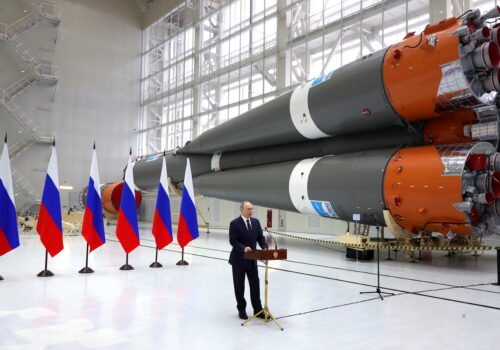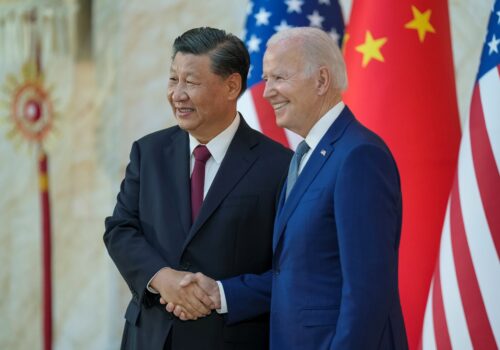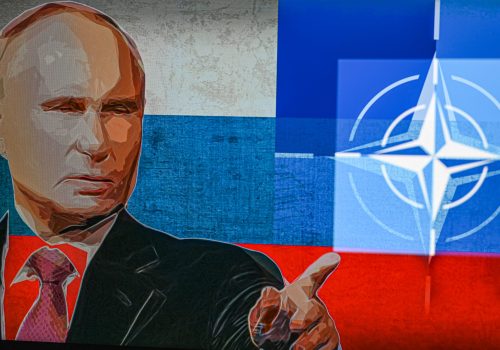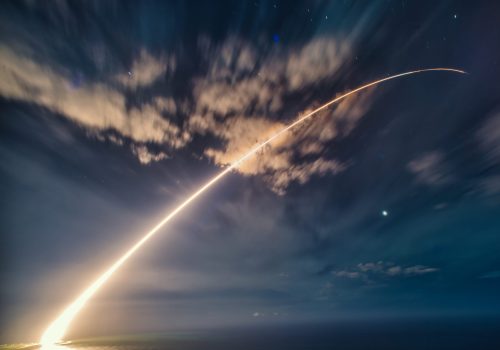Experts react: What to know about Russia’s apparent plans for a space-based nuclear weapon
Is this a Sputnuke moment? Russia is reportedly developing a space-based nuclear anti-satellite weapon. The news broke on Wednesday after House Intelligence Committee Chair Mike Turner released a cryptic statement on social media urging US President Joe Biden to declassify information about a “serious national security threat.” A White House spokesperson said on Thursday that the Russian system, which is not yet in orbit, does not pose a direct threat of “physical destruction” on Earth. However, it has raised new fears about the possibility of Russia destroying critical US satellites and an arms race in space. Atlantic Council experts will share their insights on the developments in three . . . two . . . one . . .
Click to jump to an expert analysis:
Clementine G. Starling: Russia can already detonate nuclear weapons in space from Earth
Robert M. Soofer: The US needs to modernize its nuclear and space forces
Mark J. Massa: Russia has been experimenting with “exotic” nuclear weapons
Thomas Warrick: Three possible reasons why Turner drew attention to this threat
Jacob Mezey: Russia’s nuclear recklessness in space might spur China and the US to work together
Russia can already detonate nuclear weapons in space from Earth
A nuclear-powered Russian satellite is potentially less alarming than a nuclear-armed satellite, since it would neither be norm-shattering nor give Russia the ability to degrade a large swath of all satellites on orbit in one fell swoop.
Because Russia can already detonate nuclear weapons in space from Earth, a new nuclear-armed anti-satellite weapon (ASAT) likely would not give Moscow significant new military capability, even though it remains concerning. While a nuclear-armed ASAT would advance Russian counterspace capabilities, challenge US space strategy, undermine norms, and alarm allies, it does not appear to add a qualitatively different capability to the Russian arsenal.
—Clementine G. Starling is the director of the Atlantic Council’s Forward Defense program and a resident fellow within the Scowcroft Center for Strategy and Security. Read more from Starling on this issue here.
The US needs to modernize its nuclear and space forces
This report, if true, should come as no surprise to the US government, which has been tracking Russian and Chinese anti-satellite capabilities for some years now, including ground- or space-based high-powered lasers. Presumably, armed with this awareness, the Department of Defense is taking appropriate measures to counter this threat. The key to successful nuclear deterrence is a survivable nuclear retaliatory force, including nuclear command and control—these are priorities for the US Department of Defense.
This situation is reminiscent of Russia’s development of transcontinental underwater nuclear torpedoes and nuclear-powered/nuclear-armed cruise missiles; these “novel” nuclear systems do not add appreciably to Russia’s existing capabilities to threaten the United States. Then why does Russian President Vladimir Putin field them? Perhaps it’s to shore up his domestic base or divert global attention from a failing state. Regardless, the US response must be to continue to modernize its nuclear—and space—forces to ensure that no combination of adversaries could ever contemplate a successful disarming first strike against the United States. It’s a good sign that Congress is concerned about these matters—it will have an opportunity to understand the US response as the congressional hearing season unfolds.
—Robert M. Soofer is a senior fellow in the Forward Defense practice of the Atlantic Council’s Scowcroft Center for Strategy and Security, where he leads its Nuclear Strategy Project. He was deputy assistant secretary of defense for nuclear and missile defense policy from April 2017 to January 2021.
Russia has been experimenting with “exotic” nuclear weapons
In recent years, Russia has announced the development of several new so-called “exotic” nuclear weapons—including a nuclear-powered, nuclear-armed cruise missile and submarine drone—which Western analysts have found challenging to understand. While there are plausible ways in which a nuclear-armed ASAT could be more effective than a nuclear detonation in space delivered by an intercontinental ballistic missile, such a development may be more similar in practical effect to the rest of this class of exotic nuclear weapons.
—Mark J. Massa is a deputy director in the Forward Defense practice of the Scowcroft Center for Strategy and Security at the Atlantic Council. Read more from Massa on this issue here.
Three possible reasons why Turner drew attention to this threat
House Intelligence Committee Chair Mike Turner’s request to declassify intelligence on a new Russian capability was striking because of Turner’s reputation for being serious about national security and the protection of intelligence sources and methods. I think that Turner was trying to win a trifecta—and he deserves the win.
First, national security Democrats and Republicans have been trying for months to get Congress to renew a crucial legal authority for foreign intelligence collection under section 702 of the Foreign Intelligence Surveillance Act (FISA). Jon Darby and I have described section 702 as “the most timely, impactful, and cost-effective authority to obtain foreign intelligence on terrorists, spies, weapons proliferators, cyber attackers, and nation-states that pose threats to the United States and our allies.” Reasonable reforms of the current law are entirely justified, but an unlikely alliance of progressive Democrats and pro-Donald Trump Republicans have tried to restrict the US intelligence community’s ability to use information collected under 702. A crucial vote scheduled for this week looked to go sideways, causing House leadership to pause the vote. Turner’s disclosure that this important new threat was revealed by intelligence collected under section 702’s authority should warn hesitant House members that the country’s security absolutely depends on renewing section 702.
The second potential motive for declassification has a good, if unorthodox, reason behind it. Normally, interested House members read and are briefed on threats by coming to the Intelligence Committee’s special rooms for reviewing highly classified intelligence—which, for security reasons, are a little out of the way of the routes most House members walk during their workday. Not all House members take this responsibility seriously enough. Declassifying this information will force all House members to confront the reality of this threat and may motivate them to go read the full, classified intelligence and vote accordingly.
The third reason—getting House members to realize that Russia is a threat to our national security and that they should support our allies and partners, including Ukraine—is an obvious reason, as well.
I think Turner is three for three. The Biden administration should support his request and declassify as much of the information as it can.
—Thomas S. Warrick is the director of the Future of DHS project at the Scowcroft Center for Strategy and Security’s Forward Defense practice and a nonresident senior fellow and the Scowcroft Middle East Security Initiative at the Atlantic Council.
Russia’s nuclear recklessness in space might spur China and the US to work together
National security wonks in Washington are buzzing after reports that Russia is developing a nuclear system in space for anti-satellite purposes. It is currently unclear whether the system is armed with a nuclear warhead to directly destroy satellites or if it is instead powered by a nuclear reactor for electronic warfare purposes. However, if the system is nuclear-armed, it is worth understanding what the physical effects of such a nuclear explosion in space would be and how the world might respond. If Russia detonated such a weapon, it could damage the vast majority of commercial and military satellites in orbit. Upon detonation, high-energy x-rays would destroy the electronics of all satellites not obscured by the Earth, likely knocking out the Global Positioning System (GPS). In the following weeks, charged particles generated by the blast would be trapped by the Earth’s natural radiation belts and spread around the globe, damaging all satellites except those with a high degree of radiation shielding. When the United States detonated a nuclear weapon at high-altitude in the Starfish Prime test of 1962 a third of all satellites in orbit were eventually destroyed by this effect. In 1962, there were just 24 satellites in orbit. Today there are more than seven thousand.
Given the potential crippling outcome to the global economy and to militaries, this issue should be of utmost priority to the entire world. The United States should clarify whether the weapon is, in fact, nuclear-armed. If so, international pressure, especially from China, would be critical to preventing Russia from deploying the system in space. China operates the second-most satellites of any country and might find common ground with the United States in stopping this threat. If Russia deployed the weapon in space, deterring its use in a major crisis would be difficult since the United States could not threaten to respond in-kind. Therefore, the only alternative would be planning to shoot down the system before it detonated.
While the United States does not officially possess or have plans to develop an anti-satellite capability, it has demonstrated the ability of an SM-3 missile to target satellites in low-Earth orbit. Such an event could spark an unlikely alliance, since China has tested anti-satellite capabilities and might be willing to cooperate given the threat to its ambitions in space. Regardless of whether this Russian system is indeed a nuclear weapon, this revelation could be good for US-China relations at a time when officials are attempting to jump-start arms control talks. Preserving peaceful access to space could help pave the way for broader discussions on strategic stability.
—Jacob Mezey is a program assistant in the Forward Defense practice of the Atlantic Council’s Scowcroft Center for Strategy and Security. He contributes to the program’s research on nuclear security, space security, defense innovation and modernization, and gray zone conflict.
Further reading
Fri, Feb 2, 2024
Requirements for nuclear deterrence and arms control in a two-nuclear-peer environment
Report By
Gregory Weaver and Amy Woolf discuss the future of US nuclear posture and arms control, as the United States will soon face two adversaries with peer nuclear arsenals.
Thu, Aug 31, 2023
Putin’s Russia must not be allowed to normalize nuclear blackmail
UkraineAlert By Olivia Yanchik
Vladimir Putin has used nuclear threats to intimidate the West and reduce the flow of military aid to Ukraine. If this trend does not change, Russia will succeed in normalizing nuclear blackmail as a foreign policy tool, writes Olivia Yanchik.
Wed, Nov 15, 2023
US homeland missile defense: Room for expanded roles
Issue Brief By
Matthew Costlow & Robert Soofer explore how expanded roles for US homeland missile defense could enhance deterrence with two nuclear peers
Image: The Soyuz MS-18 spacecraft carrying three Expedition 65 crewmates is pictured during its relocation maneuver from the Rassvet module to the Nauka multipurpose laboratory module Sept. 28, 2021. Credits: NASA via Sipa USA



